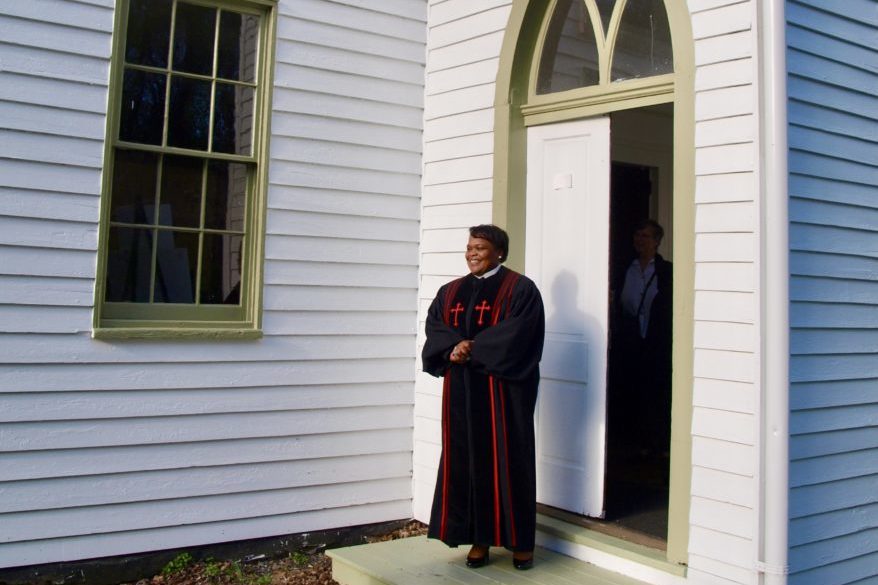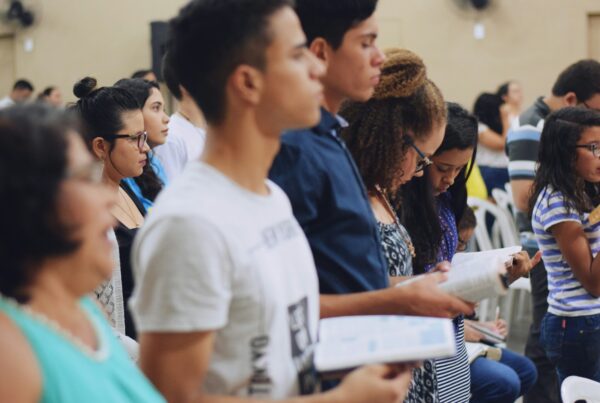Imagine there are a few new people standing outside your church. What are they wondering as they stand there? Well, one of the most basic things might be “How do I get inside?” (We’ll discuss that in a moment.) As they stand outside your church doors, they might have deeper questions, too. They might be whispering to themselves, “Will I be welcomed? Can I belong here? Is there a place for me?” North Americans report being more lonely and isolated than ever. No matter what our age or stage in life, we thirst for authentic community, where we can find our place and contribute. We long to belong, to be accepted and find refreshment and peace for our souls. How can your church welcome those visitors with the greatest hospitality?
Just as Mary and Joseph were searching for a room in the inn all those years ago, there are people all around us who are searching. People whom God is drawing especially near to during this holy season, beckoning them into deeper relationship through the story of a wee baby being born under a star-filled sky. The Holy Spirit is inviting them, ever so gently, to find a place of belonging in the body of Christ. What an opportunity for the church, and one that raises this 50-million-dollar question: How can you and your congregation welcome newcomers with open arms? How can you offer a gentle, hospitable embrace that gives them space to discover a sense of belonging, to feel what it’s like to know that God loves them beyond their wildest imaginings, and to find a place among you, a place to call their spiritual home?
The most important thing to remember in welcoming people into your church is that they are outsiders (hopefully just temporarily!). They cannot possibly know all the things your congregants know and so you must make a special effort to communicate simply and clearly about all the wonderful things you are doing to celebrate the season.
Below are eight great ways to create a welcoming environment for your neighbors, family, and friends to feel the love of Jesus this holiday season:
1. Hospitality from the outside
First consider the outward focus. Take a look at your worship and events marketing. Many times we unintentionally make our Advent activities into “insiders’ events” by not providing full information for a first-timer.
This means including not just the what, but also the why, who, where, and when on any invitations or on your church website. Mention simple things like your church address, the room an event will be held in, if there is parking and where to find it, and even which door to enter through. (Believe it or not, this is a major hindrance for many newcomers!)
Do a full survey of all the places you are promoting things: in the bulletin, at the welcome kiosk, on banners outside the church, in local papers, and on social media. Ask yourself: Does every single one of our promotions include the full name and address of our church? Is “all are welcome” included? What about, in appropriate cases, “free childcare”? If you have other languages spoken, do you note that? (Think “Hablamos español,” We speak Spanish, or even “Les esperamos,” We are waiting for you.) Do you have special accommodations for people with hearing or mobility limitations?
Remember, you may know all this, but someone coming to your church for the time has no idea.
2. Hospitality inside the building
Next, look within. Gather your hospitality team and walk through a newcomer’s experience from start to finish. (Keep in mind especially the experience of someone who was not raised in a church and isn’t familiar with church culture.)
Use the review from part 1 to help you think through how newcomers will know they are welcome and will feel included. Besides needing clear information about what the event is and when and where it will be held, they might also be wondering these things:
- Is it welcoming to my whole family?
- Can I come alone?
- Will someone greet me?
- Is there (free, safe) childcare?
- Is it okay if English is not my first language?
- Is there a charge or is it free?
- If paying is a hardship, is there a scholarship or reduced price option?
- Is it accessible for me if I have a disability?
- Will there be food and drink, and what kind?
- How long does the service or event last?
Make an effort to think through each of those questions as a team. Then make sure there is clear signage to the correct entrance. Have a greeter or two in place who is prepared to welcome people warmly and direct them to the appropriate place. (If your team is unused to having visitors, now is the time to figure out what to say and do to welcome someone completely new.) Have clear signs for things like the restroom, the drinking fountain, coat rack, nursery, mother’s room, and fellowship hall.
Another way to be welcoming is to help people know what will be happening at an event. It’s a tremendous act of hospitality to have either a paper or digital flow of the event. This has gone off-trend in many churches, but it is a wonderful and welcoming tool to help newcomers get their bearings and participate. If a flow or agenda isn’t possible, make sure the worship leader or event host verbally gives light information on what is coming next.
As a hospitality team, take an actual walk through your church together to answer these questions in real time, seeing how your church fulfills the needs and provides a truly welcoming environment from start to finish. You will no doubt have a few excellent a-ha moments!
3. Focus on both/and
When planning events and worship services, focus on both/and. This means young and older, families and singles, cherished traditions and one or two new ones, day and evening events, sacred and social activities. Having a variety of opportunities for new folks to enter into the life of the church is a wonderful way to draw folks in. People like options! And you may just find your current congregation is energized and excited, too.
4. Host community events
Avoid the insiders’ events by holding community activities that help seekers connect with your church. Post invitations across your neighborhood, libraries, and local businesses, letting folks know that all are welcome.
Here are a few ideas:
- A festive Christmas movie with hot cocoa and popcorn
- A cookie decorating party for local skilled nursing residences
- Christmas caroling at a senior center (bonus: invite local civic music groups and school choruses to participate)
- Advent wreath making: teach a simple lesson and help families make their own to take home, and get a local nursery to donate the wreaths at no or low cost
5. Look at the big picture and be strategic
When planning the holiday season, hold a meeting with leaders from all your ministries to map out the calendar. Note where there are places to collaborate. For example, the seniors and youth group could get together to make care packages for shut-ins; the adult and children’s choirs could jointly lead a Sunday afternoon carol sing with cookie decorating afterwards; the family and singles ministries could get together to make Advent wreaths and learn the tradition of lighting a candle each week.
The more the merrier, and it opens up space for new ideas and creating a spirit of togetherness. Note whether there are events that are overlapping, so that you can try to minimize time conflicts. Having collaborative events draws in new people since many folks are seeking community and welcome the chance to see different ministries and generations in action together.
6. Honor holiday nostalgia by sharing stories
Many newcomers (and long-time members, too!) are either nostalgic or melancholy about their memories of Christmases past. Hold this gently and honor the fact that each person has their own story of what Christmas has meant to them. Consider holding an informal story-sharing time where people share their stories over hot cocoa or coffee.
7. Be ready for walk-ins
Be ready for people who come at the last minute. Always, always warmly welcome them, even and especially if they didn’t RSVP, aren’t wearing “appropriate” clothes, or don’t seem comfortable being in church. Somehow they listened to God’s voice telling them to join you and this is cause for celebration and rejoicing. Ask them their names and be sure to give them some logistical information, like long the service will be, where the bathrooms are, and what happens afterward (for instance, whether you have a coffee hour).
Fun tip: Design your Christmas pageant with parts that kids can play even if they walk in on Christmas Eve.
8. Follow up with visitors
Finally, what happens next? Consider having “exit greeters” who say farewell to folks and invite them to return. At the end of any event or service, be sure to invite newcomers back and name one or two opportunities. Tell them that you are excited to see them again and that you hope they enjoyed their time among you. Let them know you will be praying for them and can be reached during the week if they have questions.
If your church records names and contact info of visitors, be sure to contact newcomers gently within 48 hours—a light, warm, authentic “thanks for joining us” note, email, or voice message that lets them know you enjoyed their presence and hope to see them again. Keep the tone gentle; after all, this journey is God-led, and our job is simply to be hospitable and relational as they take a next step.
I hope a few of these ideas resonate with you! The good news is that ministry of hospitality is a year-round, ongoing endeavor. You can try a few simple things to get started and then layer in more as your team figures out what works best in your unique context. During this Advent and Christmas season, we are really all pilgrims on the journey towards the manger in Bethlehem. What a wonderful chance we have to welcome others to join us, to find their belonging in the body of Christ.
If you would like to chat more about how to create a welcoming environment at your church, please feel free to contact me at etesta@rca.org. Nothing brings me greater joy than dreaming and envisioning ways to invite others into authentic relationship with Christ and find their spiritual home.

Rev. Liz Testa
Rev. Liz Testa is director of women’s transformation and leadership for the Reformed Church in America. She hosted four seasons of the Lavish Hope podcast. She is passionate about creating a sense of belonging and nurturing the gifts and leadership of others. You can connect with Liz by email at etesta@rca.org.



